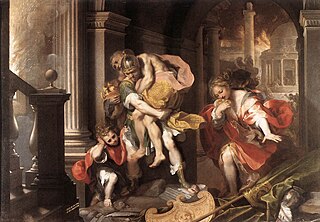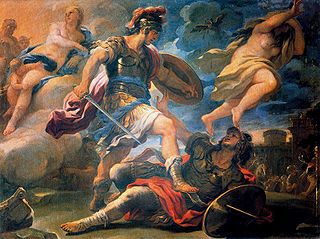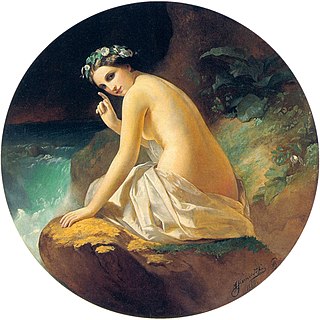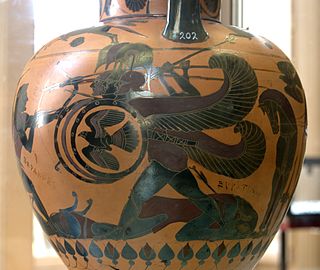
Gaius Cilnius Maecenas was a friend and political advisor to Octavian. He was also an important patron for the new generation of Augustan poets, including both Horace and Virgil. During the reign of Augustus, Maecenas served as a quasi-culture minister to the Roman emperor but in spite of his wealth and power he chose not to enter the Senate, remaining of equestrian rank.

Publius Vergilius Maro, usually called Virgil or Vergil in English, was an ancient Roman poet of the Augustan period. He composed three of the most famous poems in Latin literature: the Eclogues, the Georgics, and the epic Aeneid. A number of minor poems, collected in the Appendix Vergiliana, were attributed to him in ancient times, but modern scholars consider his authorship of these poems to be dubious.

The Aeneid is a Latin epic poem that tells the legendary story of Aeneas, a Trojan who fled the fall of Troy and travelled to Italy, where he became the ancestor of the Romans. Written by the Roman poet Virgil between 29 and 19 BC, the Aeneid comprises 9,896 lines in dactylic hexameter. The first six of the poem's twelve books tell the story of Aeneas' wanderings from Troy to Italy, and the poem's second half tells of the Trojans' ultimately victorious war upon the Latins, under whose name Aeneas and his Trojan followers are destined to be subsumed.

In ancient Roman religion and myth, Faunus was the rustic god of the forest, plains and fields; when he made cattle fertile, he was called Inuus. He came to be equated in literature with the Greek god Pan, after which Romans depicted him as a horned god.

In Greek mythology, Teucer, also Teucrus, Teucros or Teucris, was the son of King Telamon of Salamis Island and his second wife Hesione, daughter of King Laomedon of Troy. He fought alongside his half-brother, Ajax, in the Trojan War and is the legendary founder of the city of Salamis on Cyprus. Through his mother, Teucer was the nephew of King Priam of Troy and the cousin of Hector and Paris—all of whom he fought against in the Trojan War.

In Greek mythology, Amphiaraus or Amphiaraos was the son of Oicles, a seer, and one of the leaders of the Seven against Thebes. Amphiaraus at first refused to go with Adrastus on this expedition against Thebes as he foresaw the death of everyone who joined the expedition. His wife, Eriphyle, eventually compelled him to go.

In Roman mythology, Evander was a culture hero from Arcadia, Greece, who was said to have brought the pantheon, laws, and alphabet of Greece to ancient Italy, where he founded the city of Pallantium on the future site of Palatine Hill, Rome, sixty years before the Trojan War. He instituted the festival of the Lupercalia. Evander was deified after his death and an altar was constructed to him on the Aventine Hill.

In Greek and Roman mythology, Iapyx, Iapux or Iapis was a favorite of Apollo. The god wanted to confer upon him the gift of prophecy, the lyre, etc.; but Iapyx, wishing to prolong the life of his father, preferred the more tranquil art of healing to all the others.

Turnus was the legendary King of the Rutuli in Roman history, and the chief antagonist of the hero Aeneas in Virgil's Aeneid.
According to Roman mythology, Amata was the wife of Latinus, king of the Latins, and the mother of their only child, Lavinia. In the Aeneid of Virgil, she commits suicide during the conflict between Aeneas and Turnus over which of them would marry Lavinia.

In Roman mythology, Marica was a nymph, the mother of Latinus. Latinus was fathered by Faunus, who was also occasionally referred to as the son of Marica. The sacred forest near Minturnae was dedicated to Marica. A lake nearby was also named after her. Various Roman authors claims that she was a form of Diana or Venus.

In Vergil's Aeneid, Erulus is a king of Praeneste. At birth, he was given three souls (animae) by his mother, the goddess Feronia, who also tripled his ability to defend himself by giving him three sets of arms.

Tivoli is a town and comune in Lazio, central Italy, 30 kilometres north-east of Rome, at the falls of the Aniene river where it issues from the Sabine hills. The city offers a wide view over the Roman Campagna.
The Odes are a collection in four books of Latin lyric poems by Horace. The Horatian ode format and style has been emulated since by other poets. Books 1 to 3 were published in 23 BC. A fourth book, consisting of 15 poems, was published in 13 BC.
Lucius Varius Rufus was a Roman poet of the early Augustan age.

Chaonia or Chaon was the name of the northwestern part of Epirus, the homeland of the Epirote Greek tribe of the Chaonians. It was one of the three main areas of ethnic division of Epirus, the other being Molossia and Thesprotia.

Messapus, a character in Virgil's Aeneid, appears in Books VII to XII of the Latin epic poem. He was a son of Neptune, a famous tamer of horses, and king of Etruria, known for being one "whom no one can fell by fire or steel".
Michael Courtney Jenkins Putnam is an American classicist specializing in Latin literature, but has also studied literature written in many other languages. Putnam has been particularly influential in his publications concerning Virgil‘s ‘’Aeneid‘’. He is the son of politician and businessman Roger Putnam. Putnam received his B.A., M.A., and Ph. D. from Harvard. After receiving his Ph.D. in 1959 he taught at Smith College for a year. He then moved on to teach at Brown University and serving as W. Duncan MacMillan II Professor of Classics and a professor of comparative literature for 48 years before retiring in 2008. He was awarded the 1963 Rome Prize,and was later a Resident (1970) and Mellon Professor in Charge of the Classical School (1989-91). He was elected to the American Academy of Arts and Sciences in 1996 and the American Philosophical Society in 1998.
In Greek and Roman mythology, Salius is an Acarnanian who in one alternative tradition was the legendary founder of the ancient Roman priesthood of the Salii.

Johannes (Hans) Grüninger (1455–1533) was a German printer whose career spanned from 1482 to 1533 and produced up to 500 publications. Grüninger was one of the single most prolific printers of Strasbourg, printing up to 80 books a year. While a great deal of his publications were Catholic, he managed to print a great variety of works ranging from humanist to scientific texts. His work was fairly equally representative of both Latin and the vernacular; about 39% of his works were printed in Latin and the remaining 61% in German.














